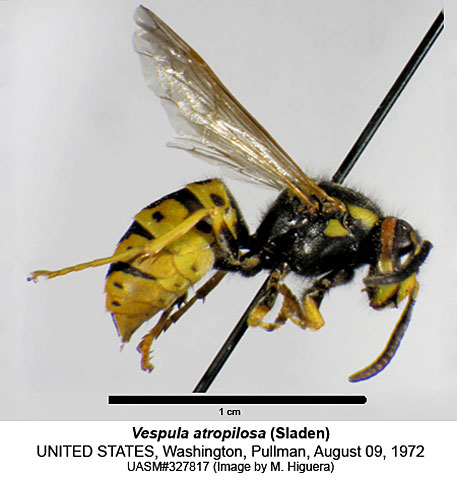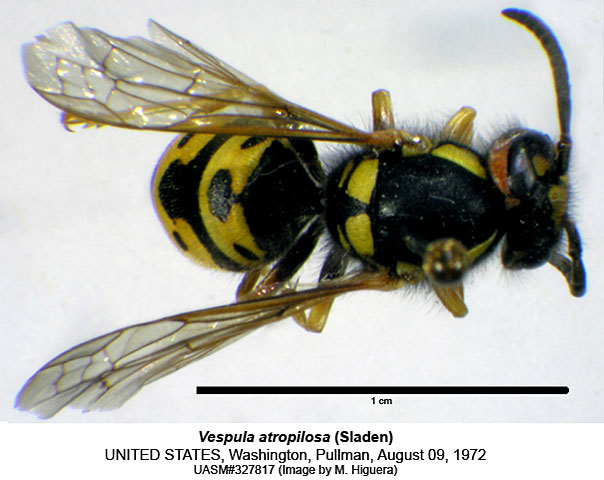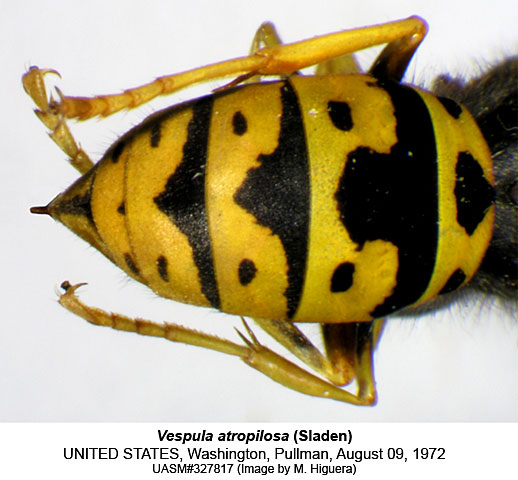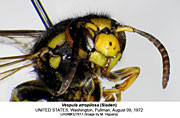Species Details
Vespula atropilosa
University of Alberta E.H. Strickland Entomological Museum Read more about this collection »
Common NamePrairie Yellowjacket
SeasonalityThe colony starts in late April or May and decline in late September or October and the nest remain from spring to fall.
IdentificationThis species is black with yellow markings; size between 10 mm and 15 mm. Head: the malar space is below than half as long as the penultimate antennal segment; the occipital carina is incomplete; the ventral part of the scape is yellow opposite the dorsal part of the scape is black. Metasoma: the metasomal tergites are covered with long straight hairs; the central black region of the apex of the second gastral tergum is pointed; male aedeagus with saddle-shaped portion. In some locations the male exhibits two different abdominal color patterns: a xanthic phase with more black than yellow and a melanic phase with more yellow than black (Miller 1961, VanDyk 2003).
Scientific Name
Vespula atropilosa
Common Name
Prairie Yellowjacket
Habitat
Neartic species limited to northern region in prairies and grasslands. This species is less abundant in dense forests.
Seasonality
The colony starts in late April or May and decline in late September or October and the nest remain from spring to fall.
Identification
This species is black with yellow markings; size between 10 mm and 15 mm. Head: the malar space is below than half as long as the penultimate antennal segment; the occipital carina is incomplete; the ventral part of…
This species is black with yellow markings; size between 10 mm and 15 mm. Head: the malar space is below than half as long as the penultimate antennal segment; the occipital carina is incomplete; the ventral part of the scape is yellow opposite the dorsal part of the scape is black. Metasoma: the metasomal tergites are covered with long straight hairs; the central black region of the apex of the second gastral tergum is pointed; male aedeagus with saddle-shaped portion. In some locations the male exhibits two different abdominal color patterns: a xanthic phase with more black than yellow and a melanic phase with more yellow than black (Miller 1961, VanDyk 2003).
Life History
The Prairie Yellowjacket is a social species with annual colonies. In later April or early May the queens emerge from diapauses and them looking for nesting places, generally they fly 20 cm above the ground; most…
The Prairie Yellowjacket is a social species with annual colonies. In later April or early May the queens emerge from diapauses and them looking for nesting places, generally they fly 20 cm above the ground; most queens begin the nest in deserted rodent burrows (Akre et al. 1976). The successful queen burrows about 10-30 cm underground, aerial nest are uncommon. The queen adds cells inside the nest, she lays eggs and takes care of the larvae, the first workers emerge in early June and the queen doesn’t leave the nest again. The workers search food and fibers, care the larvae, clean the cells, feed the queen, the larvae and the males, they exhibit trophallaxis, mauling and ovoposition behavior, and also they protect the colony (Akre et al. 1976). The average of lifespan of a worker is 48 days. The males emerge in mid August, finally the colony decline in September. For the workers the life cycle is completed in approximately 75 days, the queens live more than 5 months. Inside the nest the pupal parasite Sphecophaga vesparum, affect adversely the development of young colonies, S. vesparum may destroy new colonies or retard the normal growth of the colony, the Prairie Yellowjackets workers tend to ignore S. vesparum even if they touch them with the comb (MacDonald et al. 1975, Akre et al. 1976)
Conservation
This species is common and this is not reported in vulnerability status.
Diet Info
They feed regularly on live prey. They are mostly predators of spiders, harvestmen, caterpillars, flies, hemipterans, soft beetles, butterflies, moths and other bugs, however, this species avoid crickets and slugs.…
They feed regularly on live prey. They are mostly predators of spiders, harvestmen, caterpillars, flies, hemipterans, soft beetles, butterflies, moths and other bugs, however, this species avoid crickets and slugs. The adults carry their prey or part of them to the nest to feed their larval states. They also feed of flower nectar or sweet substances (Akre et al. 1976).
Range
This species is restricted to western of North America from Canada to United States. In Canada the species is distributed from central British Columbia to south and east in southern Alberta. In United States this…
This species is restricted to western of North America from Canada to United States. In Canada the species is distributed from central British Columbia to south and east in southern Alberta. In United States this species ranging from Seattle to Arizona. Alberta: Lethbridge, Medicine Lake, Pincher, Waterton. British Columbia: Crankbrook, Fairview, Kamloops, Merrit, Oliver, Penticton, Summerland, Vernon. United States: Arizona, Colorado, Idaho, Montana, Nevada, Oregon, South Dakota, Utah, Washington, Wyoming (GBIF 2011, Miller 1961).
Notes
This species is substituted for Vespula acadica in dense forest. Some V. atropilosa males have an intermediate color pattern with V. acadica, however, Miller (1958) suggest that they are the result of hybridization…
This species is substituted for Vespula acadica in dense forest. Some V. atropilosa males have an intermediate color pattern with V. acadica, however, Miller (1958) suggest that they are the result of hybridization process between these species or parallel evolution, but Miller (1961) recognized the identity of both species as good species.
References
Title
Vespula consobrina and Vespula atropilosa.
Author
Akre, R. D., Garnett, W. B., Mac Donald, J. F., Greene, A. and Landolt, P.
Title
Behavior and colony development of Vespula pensylvanica and V. atropilosa (Hymenoptera: Vespidae).
Publication Date
1976
Series Title
Journal of the Kansas Entomological Society
Volume
49
Pages
63-84
Author
VanDyk, J.
Title
BugGuide Identification, Images & Information, for insects, spiders & their skin, for the United States & Canada.
Publication Date
2003
Author
Miller, C. D. F.
Title
Distributional and nomenclatorial problems in some forms of Vespula in North America (Hymenoptera: Vespidae).
Publication Date
1958
Series Title
Proceedings of the tenth International Congress of Entomology Montreal, Aug. 17-25, 1956
Volume
1
Pages
257-264
Author
MacDonald, J. F., Akre, R. D. & Hill, W. B.
Title
Location and structure of nests of Vespula atropilosa and V. acadica (Hymenoptera:Vespidae).
Publication Date
1975
Series Title
Journal of the Kansas Entomological Society
Volume
48
Pages
114-121
Author
Miller, C. D. F.
Title
Taxonomy and distribution of Nearctic Vespula.
Publication Date
1961
Series Title
The Canadian Entomologist. Supplement
Volume
22
Pages
1-52
DOI
10.4039/entm9322fv
Specimen Information
There are 3 specimens of this Species.
UASM327816 - Vespula atropilosa
University of Alberta E.H. Strickland Entomological Museum
Place CollectedCanada: Alberta, Medicine Hat
Collected ByStrickland, E. H.
Date Collected1939-08-09
UASM327817 - Vespula atropilosa
University of Alberta E.H. Strickland Entomological Museum
Place CollectedUnited States: Washington, Whitman county, Pullman
Collected ByWhitman
Date Collected1972-08-09
UASM327818 - Vespula atropilosa
University of Alberta E.H. Strickland Entomological Museum
Place CollectedUnited States: Wyoming, Carbon county, Medicine Bow National Forest
Collected ByJacobson, R. S.
Date Collected1975-07-07







